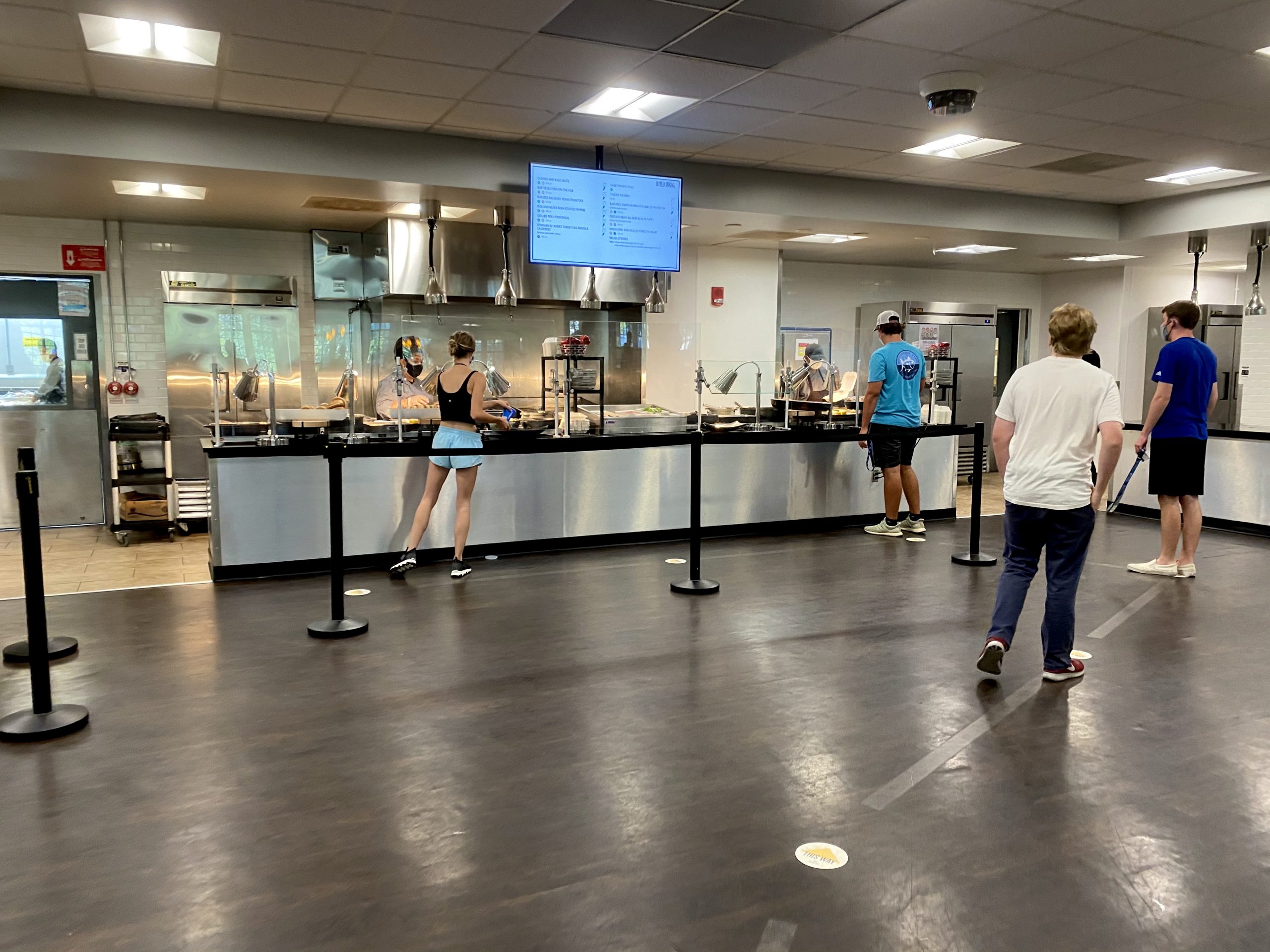Atherton Union changes its dining options and procedures amidst the COVID-19 pandemic. Photo by Evalyn Peacey.
STASIA RAEBEL | STAFF REPORTER | smraebel@butler.ed
From lines of students spread 6 feet apart to plexiglass barriers dividing tables, dining at Butler looks different this year.
Senior Allison Kinsinger, a health science major, noticed these differences. Kinsinger used to enjoy her meal with friends in the dining hall, but now she finds it hard to hear with the plexiglass dividing her from her friends. As a result, they choose to find new locations — like the benches outside, for example — to eat their meals.
Kinsinger said she and her friends try to avoid the lunch and dinner rushes, where the wait times are the longest and the large groups of people make social distancing a challenge.
“I have seen social distancing once we have gotten into the dining hall, but it is difficult to social distance before the cash register,” Kinsinger said. “So the line kind of bunches up before that.”
She also said it has been challenging getting used to this new normal in the dining halls.
Lee Van Driest, a first-year history and criminology and sociology double major, noticed another trend in social distancing.
“[The staff] try to keep us socially distanced,” Van Driest said. “Sometimes it works, sometimes it doesn’t. We are socially distanced from everyone else for the most part, but your friend group always stays close together.”
The university placed markings 6 feet apart on the floor in the dining halls, but the lines of students have extended far enough that some had to wait outside of Atherton Union during the busiest points of the dinner rush.
“I have found wait times to be about 20 minutes,” said Kinsinger.
The lines are not the only thing that is different about dining at Butler this year. While there used to be multiple stations for students to choose what they want to eat, the locations are more limited this year.
Mandy Rentschler, marketing director of Bon Appetit, discussed how, before COVID-19, students would spend around ten minutes standing in the dining halls just trying to figure out what they wanted to eat. They tried to limit this decision time by changing the model of Resco and have it “mimic what Atherton has been in the past.”
Butler will be using an ordering app called Boost to allow students to navigate the dining halls in a quicker fashion. More information on the app will be released this week.
Students can use their meal swipes at both Atherton Union and Resco, and both locations now serve the same food. This allows students to go to either main dining hall without having to consider the meal options.
Makenna Territo, a first-year political science major, said she thinks this system works better within the health and safety parameters than the previous system would have.
“I think the idea of having the same things at Resco and Atherton makes a lot of sense,” Territo said. “I think [the old system] could have caused excessive lines, so I think what we are doing now has improved this a lot because it could have been a greater problem.”
Kinsinger recognizes that the dining options had to be simplified due to COVID-19, but she misses some of the variety that the dining halls used to have, specifically the salad bar and sandwich bar. Now these items are prepackaged for students, and they do not get as many choices. Territo, on the other hand, feels like there is a good variety in meal options.
“They’ve been doing a good job lately of striking a balance between providing healthy food for the people who want it and pizza/burger like fair type for the people who don’t want it,” Territo said.“I feel like [variety] is getting better as time goes on.”
Even though there is less variety than there has been in the past, Rentschler assured students that all of the food is still made from scratch. She also said the food is still made with several products from local farms, and their close connection with local food providers have had few changes due to COVID-19.
The students are not the only ones facing different realities this semester. Dining staff had to go through an additional half day of training in response to COVID-19, and each individual location had their staff go through more training to be prepared.
The staff is now relying on catering techniques, rather than standard cafeteria cooking, to adjust to the new system. The kitchen staff must also follow social distancing guidelines and one-way traffic areas in between cooking stations.
The dining changes will last throughout the semester, and there may be small changes that occur as students come back after winter break.
Students can look out for multiple services to help limit the times they are exposed to others in the dining halls. One of these services is called Menu Mail, in which students will receive an email at around 4:00 a.m. each morning with a list of the menus at each of the food locations for that day. This allows students to determine what they are interested in ordering before they get in line. General changes to the dining halls this year in response to COVID-19 can also be found on Butler’s dining website.



